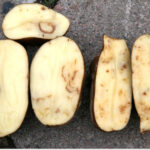Polish name: Rdzawa plamistość miąższu
English name: Internal heat necrosis
Perpetrators of the disease:
- Abiotic factors (disturbances in the plant’s water balance, unfavorable atmospheric and soil conditions)
Gallery

Internal Heat Necrosis. Symptoms on the cross-section of the tuber.
(photo by J. Osowski)

Internal Heat Necrosis. Symptoms on the cross-section of the tuber.
(photo by J. Osowski)

Internal Heat Necrosis. Symptoms on the cross-section of the tuber.
(photo by J. Osowski)
- Porównanie objawów rdzawej plamistości i wirusa TRV (fot. J. Osowski)
- Rdzawa plamistość miąższu. Objawy na przekroju bulwy (fot. S. Wróbel)
Characteristics and description of the disease
On the cross-section of the tuber, irregularly shaped spots of rust, dark brown, or even black color form (photo 1A, 1B, 1C, 1D). Typically, these spots occur inside the ring of vascular bundles and are formed by clusters of cells that have undergone necrosis (cell death). Sometimes these symptoms can be confused with the symptoms of phosphorus and calcium deficiency or those caused by the TRV virus (photo 2) – the virus symptoms are visible on the tubers on the left side of the photo.
Rusty Flesh Spotting is, alongside hollow heart, the most serious internal defect in tubers intended for consumption and processing. It occurs in all cultivation regions, with a higher intensity in dry years. Its occurrence is favored by uneven atmospheric precipitation, cultivation on sandy and permeable soils, as well as clayey soils with gravelly subsoil or low permeability. It is believed that the occurrence of rusty flesh spotting is caused by disruptions in the plant’s water balance, respiration, and nutrition due to unfavorable atmospheric and soil conditions, as well as alkaline soil pH. Greater intensity of this defect is observed in years with rapid atmospheric changes, i.e., periods of drought and rainy seasons occurring successively.
This defect does not reduce yield but significantly negatively affects its quality because it is considered a major flaw in edible potatoes (the affected tissues harden after cooking and are not suitable for consumption) and those intended for starch production (starch color is inadequately white).
Prevention:
- Avoid cultivating potatoes in sandy and permeable soils, as well as in clayey and less permeable soils. If unavoidable, choose varieties with less susceptibility to rusty flesh spotting.
- Careful cultivation practices, especially hilling and ridging, to ensure that developing tubers are covered with a layer of soil throughout the growing season.
- Mineral fertilization tailored to the needs of the variety and cultivation direction.
Compiled by: Dr. Eng. Jerzy Osowski



